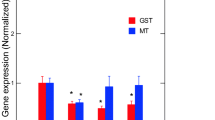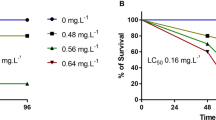Abstract
The growing use of Lanthanides in new technologies has increased their anthropogenic releases into the aquatic environment over the last decades. However, knowledge on their ecotoxicological impacts is still incomplete, especially with regard to biological effects of Lanthanides mixtures and the possible regular variation in toxicity along the Lanthanides series. The present study evaluated the individual toxicity of all Lanthanides and the toxicity of mixtures of three of them, namely Neodymium (Nd3+), Gadolinium (Gd3+), and Ytterbium (Yb3+) on Danio rerio fibroblast-like cells (ZF4). Individual and mixtures toxicity of Neodymium (Nd3+) and Ytterbium (Yb3+) were also assessed on Danio rerio hepatic cells (ZFL) and Oncorhynchus mykiss epithelial cells (RTgill-W1). The measured Lanthanide concentrations were close to the nominal ones in the culture media of ZF4, ZFL, and RTgill-W1 cells (85–99%). A toxic impact was observed on the three fish cell lines exposed to all Lanthanides tested individually. RTgill-W1 appeared as the less sensitive cells, compared to the two others. Four Lanthanides, Erbium (Er3+), Thulium (Tm3+), Ytterbium (Yb3+) and Lutetium (Lu3+) showed a higher toxicity than the others on ZF4 cells but no correlation could be established between the toxicity of Lanthanides and the order of the elements within the Lanthanides series. Exposures to binary mixtures highlighted the presence of synergistic effects on cell viability for all cell lines.



Similar content being viewed by others
References
Alonso E, Sherman AM, Wallington TJ, Everson MP, Field FR, Roth R, Kirchain RE (2012) Evaluating rare earth element availability: a case with revolutionary demand from clean technologies. Environ Sci Technol 46:3406–3414. https://doi.org/10.1021/es203515d
Altenburger R, Scholze M, Busch W, Escher BI, Jakobs G, Krauss M, Krüger J, Neale PA, Ait-Aissa S, Almeida AC, Seiler T-B, Brion F, Hilscherová K, Hollert H, Novák J, Schlichting R, Serra H, Shao Y, Tindall A, Tollefsen KE, Umbuzeiro G, Williams TD, Kortenkamp A (2018) Mixture effects in samples of multiple contaminants – An inter-laboratory study with manifold bioassays. Environ Int 114:95–106. https://doi.org/10.1016/j.envint.2018.02.013
Ansoborlo E, Prat O, Moisy P, Den Auwer C, Guilbaud P, Carriere M, Gouget B, Duffield J, Doizi D, Vercouter T, Moulin C, Moulin V (2006) Actinide speciation in relation to biological processes. Biochimie 88:1605–1618. https://doi.org/10.1016/j.biochi.2006.06.011
Bau M, Dulski P (1996) Anthropogenic origin of positive gadolinium anomalies in river waters. Earth Planetary Sci Lett 143:245–255. https://doi.org/10.1016/0012-821X(96)00127-6
Bergna HE (1994) Colloid Chemistry of Silica. In: The Colloid Chemistry of Silica, Advances in Chemistry. American Chemical Society, pp. 1–47. https://doi.org/10.1021/ba-1994-0234.ch001
Blinova I, Lukjanova A, Muna M, Vija H, Kahru A (2018) Evaluation of the potential hazard of lanthanides to freshwater microcrustaceans. Sci Total Environ 642:1100–1107. https://doi.org/10.1016/j.scitotenv.2018.06.155
Blinova I, Muna M, Heinlaan M, Lukjanova A, Kahru A (2020) Potential Hazard of Lanthanides and Lanthanide-Based Nanoparticles to Aquatic Ecosystems: Data Gaps, Challenges and Future Research Needs Derived from Bibliometric Analysis. Nanomaterials 10:328. https://doi.org/10.3390/nano10020328
Bliss CI (1939) The Toxicity of Poisons Applied Jointly1. Ann Appl Biol 26:585–615. https://doi.org/10.1111/j.1744-7348.1939.tb06990.x
Bresson C, Ansoborlo E, Vidaud C (2011) Radionuclide speciation: a key point in the field of nuclear toxicology studies. J Analy Atomic Spectrometry 26:593–601. https://doi.org/10.1039/C0JA00223B
Cabella C, Crich SG, Corpillo D, Barge A, Ghirelli C, Bruno E, Lorusso V, Uggeri F, Aime S (2006) Cellular labeling with Gd(III) chelates: only high thermodynamic stabilities prevent the cells acting as ‘sponges’ of Gd3+ ions. Contrast Media Mol Imaging 1:23–29. https://doi.org/10.1002/cmmi.88
Çelik İ, Kara D, Karadaş C, Fisher A, Hill SJ (2015) A novel ligandless-dispersive liquid-liquid microextraction method for matrix elimination and the preconcentration of rare earth elements from natural waters. Talanta 134:476–481. https://doi.org/10.1016/j.talanta.2014.11.063
González V, Vignati DAL, Pons M-N, Montarges-Pelletier E, Bojic C, Giamberini L (2015) Lanthanide ecotoxicity: first attempt to measure environmental risk for aquatic organisms. Environ Pollut 199:139–147. https://doi.org/10.1016/j.envpol.2015.01.020
Hanana H, Kleinert C, Gagné F (2021) Toxicity of representative mixture of five rare earth elements in juvenile rainbow trout (Oncorhynchus mykiss) juveniles. Environ Sci Pollut Res. https://doi.org/10.1007/s11356-020-12218-5
Hao S, Xiao-rong W, Lian-sheng W, Lemei D, Zhong L, Yi-jun C (1997) Bioconcentration of Rare Earth Elements lanthanum, gadolinium and yttrium in algae (Chlorella Vulgarize Beijerinck): Influence of chemical species. https://doi.org/10.1016/S0045-6535(97)00031-3
Herrmann H, Nolde J, Berger S, Heise S (2016) Aquatic ecotoxicity of lanthanum – A review and an attempt to derive water and sediment quality criteria. Ecotoxicol Environ Saf 124:213–238. https://doi.org/10.1016/j.ecoenv.2015.09.033
Jonker MJ, Svendsen C, Bedaux JJM, Bongers M, Kammenga JE (2005) Significance testing of synergistic/antagonistic, dose level-dependent, or dose ratio-dependent effects in mixture dose-response analysis. Environ Toxicol Chem 24:2701–2713. https://doi.org/10.1897/04-431r.1
Kerr DR, Meador JP (1996) Modeling dose response using generalized linear models. Environ Toxicol Chem 15:395–401. https://doi.org/10.1002/etc.5620150325
Kulaksız S, Bau M (2011) Rare earth elements in the Rhine River, Germany: first case of anthropogenic lanthanum as a dissolved microcontaminant in the hydrosphere. Environ Int 37:973–979. https://doi.org/10.1016/j.envint.2011.02.018
Kulaksız S, Bau M (2013) Anthropogenic dissolved and colloid/nanoparticle-bound samarium, lanthanum and gadolinium in the Rhine River and the impending destruction of the natural rare earth element distribution in rivers. Earth Planetary Sci Lett 362:43–50. https://doi.org/10.1016/j.epsl.2012.11.033
Laville N, Aı̈t-Aı̈ssa S, Gomez E, Casellas C, Porcher JM (2004) Effects of human pharmaceuticals on cytotoxicity, EROD activity and ROS production in fish hepatocytes. Toxicology 196:41–55. https://doi.org/10.1016/j.tox.2003.11.002
Li J, Hong M, Yin X, Liu J (2010) Effects of the accumulation of the rare earth elements on soil macrofauna community. J Rare Earths 28:957–964. https://doi.org/10.1016/S1002-0721(09)60233-7
Liess M, Foit K, Knillmann S, Schäfer RB, Liess H-D (2016) Predicting the synergy of multiple stress effects. Sci Rep 6:32965. https://doi.org/10.1038/srep32965
Loewe S, Muischnek H (1926) Über Kombinationswirkungen. Naunyn-Schmiedeberfs. Archiv für Experimentelle Pathologie Pharmakologie 114:313–326. https://doi.org/10.1007/BF01952257
Manusadžianas L, Vitkus R, Gylytė B, Cimmperman R, Džiugelis M, Karitonas R, Sadauskas K (2020) Ecotoxicity Responses of the Macrophyte Algae Nitellopsis obtusa and Freshwater Crustacean Thamnocephalus platyurus to 12 Rare Earth Elements. Sustainability 12:7130. https://doi.org/10.3390/su12177130
Mosmann T (1983) Rapid colorimetric assay for cellular growth and survival: Application to proliferation and cytotoxicity assays. J Immunol Methods 65:55–63. https://doi.org/10.1016/0022-1759(83)90303-4
Ng T, Smith DS, Straus A, McGeer JC (2014) Review of Aquatic Effects of Lanthanides and Other Uncommon Elements. Final Project Report. Attachment 7. Prepared for the EC Contribution Agreement with the CNTC for 2010/2011. p. 42
Norwood WP, Borgmann U, Dixon DG, Wallace A (2003) Effects of metal mixtures on aquatic biota: a review of observations and methods. Human Ecol Risk Assessment: Int J 9:795–811. https://doi.org/10.1080/713610010
Olabarrieta I, L’Azou B, Yuric S, Cambar J, Cajaraville MP (2001) In vitro effects of cadmium on two different animal cell models. Toxicol In Vitro 15:511–517. https://doi.org/10.1016/S0887-2333(01)00056-X
Pagano G, Guida M, Tommasi F, Oral R (2015) Health effects and toxicity mechanisms of rare earth elements-Knowledge gaps and research prospects. Ecotoxicol Environ Saf 115:40–48. https://doi.org/10.1016/j.ecoenv.2015.01.030
Parant M, Sohm B, Flayac J, Perrat E, Chuburu F, Cadiou C, Rosin C, Cossu-Leguille C (2019) Impact of gadolinium-based contrast agents on the growth of fish cells lines. Ecotoxicol Environ Saf 182:109385. https://doi.org/10.1016/j.ecoenv.2019.109385
Parant M, Perrat E, Wagner P, Rosin C, Py J-S, Cossu-Leguille C (2018) Variations of anthropogenic gadolinium in rivers close to waste water treatment plant discharges. Environ Sci Pollut Res Int https://doi.org/10.1007/s11356-018-3489-6
Perrat E, Parant M, Py J-S, Rosin C, Cossu-Leguille C (2017) Bioaccumulation of gadolinium in freshwater bivalves. Environ Sci Pollut Res 24:12405–12415. https://doi.org/10.1007/s11356-017-8869-9
Petersen SA, Sanville W, Stay F, Powers C (1974) Nutrient Inactivation as a Lake Restoration Procedure: Laboratory Investigations, Corvallis. ed. U.S. Government Printing Office, Oregon
Romero-Freire A, Joonas E, Muna M, Cossu-Leguille C, Vignati DAL, Giamberini L (2019) Assessment of the toxic effects of mixtures of three lanthanides (Ce, Gd, Lu) to aquatic biota. Sci Total Environ 661:276–284. https://doi.org/10.1016/j.scitotenv.2019.01.155
Rucki M, Kejlova K, Vlkova A, Jirova D, Dvorakova M, Svobodova L, Kandarova H, Letasiova S, Kolarova H, Mannerstrom M, Heinonen T (2021) Evaluation of toxicity profiles of rare earth elements salts (lanthanides). J Rare Earths 39:225–232. https://doi.org/10.1016/j.jre.2020.02.011
Sneller FEC, Kalf DF, Weltje L, Van Wezel AP (2000) Maximum Permissible Concentrations and Negligible Concentrations for Rare Earth Elements (REE). RIVM Report 601501011. National Institute of Public Health and the Environment, Bilthoven, The Netherlands (2000), p. 66
Tai P, Zhao Q, Su D, Li P, Stagnitti F (2010) Biological toxicity of lanthanide elements on algae. Chemosphere 80:1031–1035. https://doi.org/10.1016/j.chemosphere.2010.05.030
Tan Q-G, Yang G, Wilkinson KJ (2017) Biotic ligand model explains the effects of competition but not complexation for Sm biouptake by Chlamydomonas reinhardtii. Chemosphere 168:426–434. https://doi.org/10.1016/j.chemosphere.2016.10.051
Verplanck PL, Furlong ET, Gray JL, Phillips PJ, Wolf RE, Esposito K (2010) Evaluating the Behavior of Gadolinium and Other Rare Earth Elements through Large Metropolitan Sewage Treatment Plants. Environ Sci Technol 44:3876–3882. https://doi.org/10.1021/es903888t
Yang G, Sun Z, Lv X, Deng Y, Zhou Q, Huang X (2012) Living Target of Ce(III) Action on Horseradish Cells: Proteins on/in Cell Membrane. Biol Trace Element Res 150:396–402. https://doi.org/10.1007/s12011-012-9514-6
Yoshida S, Muramatsu Y, Tagami K, Uchida S (1998) Concentrations of lanthanide elements, Th, and U in 77 Japanese surface soils. Environ Int 24:275–286. https://doi.org/10.1016/S0160-4120(98)00006-3
Zhang K, Kleit AN, Nieto A (2017) An economics strategy for criticality – Application to rare earth element Yttrium in new lighting technology and its sustainable availability. Ren Sustain Energy Rev 77:899–915. https://doi.org/10.1016/j.rser.2016.12
Acknowledgements
We thank Clément Bojic and Justine Flayac for technical support in cell culture, and Danièle Pauly for the preparation of the stock solutions of Lanthanides. We warmly thank Davide Vignati for his proofreading and advice in English improvement.
Funding
This work was supported by the Lorraine region and French National Research Agency through the “Ecotoxicology of Rare Earth Elements in Aquatic Systems” project with the reference ANR-16-CE34-0012/ECOTREE.
Author information
Authors and Affiliations
Contributions
CRediT authorship contribution statement EF: Conceptualization, Methodology, Investigation, Resources, Validation, Formal analysis, Writing? original draft. MP: Conceptualization, Writing original draft, Supervision. AM: Formal statistic and modelling analysis, Writing original draft. CC-L: Conceptualization, Supervision, Writing original draft, Funding acquisition.
Corresponding author
Ethics declarations
Conflict of interest
The authors declare no competing interests.
Ethical approval
The cellular models ZF4 (ATCC® CRL-2050™) and ZFL (ATCC® CRL-2643™) cells from Danio rerio and RTgill-W1 (ATCC® CRL-2523™) cells from Oncorhynchus mykiss do not benefit from any particular protection status. No legal professional qualification is currently required for their experimental use in the laboratory.
Additional information
Publisher’s note Springer Nature remains neutral with regard to jurisdictional claims in published maps and institutional affiliations.
Supplementary Information
Rights and permissions
Springer Nature or its licensor holds exclusive rights to this article under a publishing agreement with the author(s) or other rightsholder(s); author self-archiving of the accepted manuscript version of this article is solely governed by the terms of such publishing agreement and applicable law.
About this article
Cite this article
Fleurbaix, E., Parant, M., Maul, A. et al. Toxicity of lanthanides on various fish cell lines. Ecotoxicology 31, 1147–1157 (2022). https://doi.org/10.1007/s10646-022-02574-y
Accepted:
Published:
Issue Date:
DOI: https://doi.org/10.1007/s10646-022-02574-y




